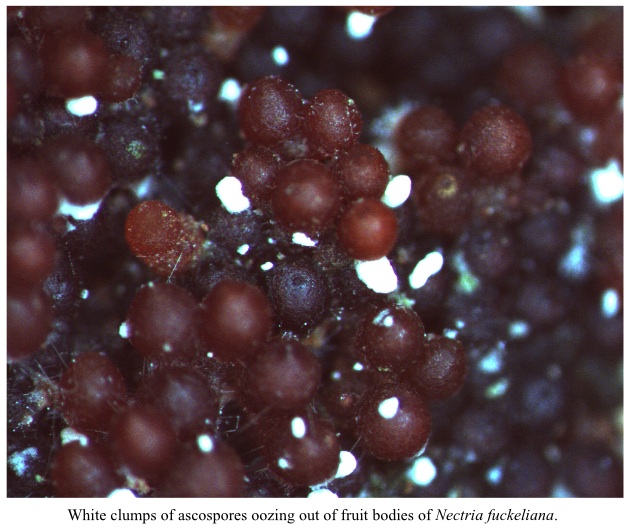PESTS AND DISEASES OF FORESTRY IN NEW ZEALAND
Research update on nectria disease of radiata pine
Scion is the leading provider of forest-related knowledge in New Zealand
Formerly known as the Forest Research Institute, Scion has been a leader in research relating to forest health for over 50 years. The Rotorua-based Crown Research Institute continues to provide science that will protect all forests from damage caused by insect pests, pathogens and weeds. The information presented below arises from these research activities.
From Forest Health News 155, September 2005.
A comprehensive research programme was begun in January this year to answer some basic questions about the ecology and epidemiology of the fungus Nectria fuckeliana , the organism most commonly associated with stem fluting of radiata pine in the lower South Island. This project is funded by the Forest Biosecurity Research Council and Foundation for Research, Science, and Technology. It is hoped that the results will go a long way to assisting plantation owners in determining operational management solutions to this problem.
 Although N. fuckeliana is the fungus most commonly isolated from trees with the fluting symptom, the relationship of the fungus to the disease is not completely understood. The fungus has a complex life cycle, producing one kind of spore in culture, but another on the bark and wounded surfaces of trees. An inoculation trial was begun in April near Dunedin to determine whether there is a difference in aggressiveness of these two spore states in causing disease. In a second inoculation experiment, planned for 2006, the early stages of infection will be observed in trees felled at regular intervals after inoculation. Examination of infected wood by confocal and scanning electron microscopy will show the location of the fungus within the tissues of the tree and the type of cellular damage it causes.
Although N. fuckeliana is the fungus most commonly isolated from trees with the fluting symptom, the relationship of the fungus to the disease is not completely understood. The fungus has a complex life cycle, producing one kind of spore in culture, but another on the bark and wounded surfaces of trees. An inoculation trial was begun in April near Dunedin to determine whether there is a difference in aggressiveness of these two spore states in causing disease. In a second inoculation experiment, planned for 2006, the early stages of infection will be observed in trees felled at regular intervals after inoculation. Examination of infected wood by confocal and scanning electron microscopy will show the location of the fungus within the tissues of the tree and the type of cellular damage it causes.
A profile of the basic biology of Nectria fuckeliana is emerging as a result of field and laboratory observations and experiments. For instance, the bright red fruiting bodies of the fungus, which appear on infected branch stubs and stem cankers, contain viable spores (ascospores) in all seasons of the year. In the laboratory, we have shown that the spores can survive for several months at room temperature or in a refrigerator when enclosed in the fruiting bodies. How long the fungus can survive in (or on) woody debris in nature will be determined from the results of field experiments begun in June this year. Such information is important for understanding the risks of transporting infected wood to other locations.
Nectria ascospores ooze out of the fruiting bodies in droplets when adequate moisture is present. It is probable that moisture also plays a part in spore dispersal through splashing or wind-borne water droplets. Knowing the mode of dispersal is important in predicting the rate and pattern of disease spread. Fungal pathogens that are spread in water droplets usually spread more slowly and cause build-up of disease in localised patches rather than over broad areas, as occurs with fungi that are primarily wind-dispersed. Spore trapping experiments are under way in Otago to correlate spore dispersal with weather conditions. Understanding the weather conditions that promote spore dispersal will make it possible for plantation owners to time the pruning of their trees for when infection risk is low.
Free water is also necessary for the Nectria ascospores to germinate. The spores can germinate at a broad range of temperatures, from 5° to 28°C. At either end of the scale, however, germination is very slow or abnormal. The optimum temperature for germination is between 18° and 25°C. Within that range, the spores rapidly produce long germ tubes that presumably could penetrate wood to cause infection if all conditions are favourable. The results so far indicate that Nectria fuckeliana is very adaptable and able to function over a broad range of conditions. In addition to the ecology work described above, Ensis Forest Biosecurity and Protection are continuing work on the effect of silviculture, stub treatment, and environment on disease development, disease susceptibility of other conifers and of Pinus radiata seedlings, and using DNA-based tools to determine the relationships between pruning, infection by Nectria and other fungi, and fluting development.
Patricia Crane (Ensis)
This information is intended for general interest only. It is not intended to be a substitute for specific specialist advice on any matter and should not be relied on for that purpose. Scion will not be liable for any direct, indirect, incidental, special, consequential or exemplary damages, loss of profits, or any other intangible losses that result from using the information provided on this site.
(Scion is the trading name of the New Zealand Forest Research Institute Limited.)

 Farm Forestry New Zealand
Farm Forestry New Zealand

